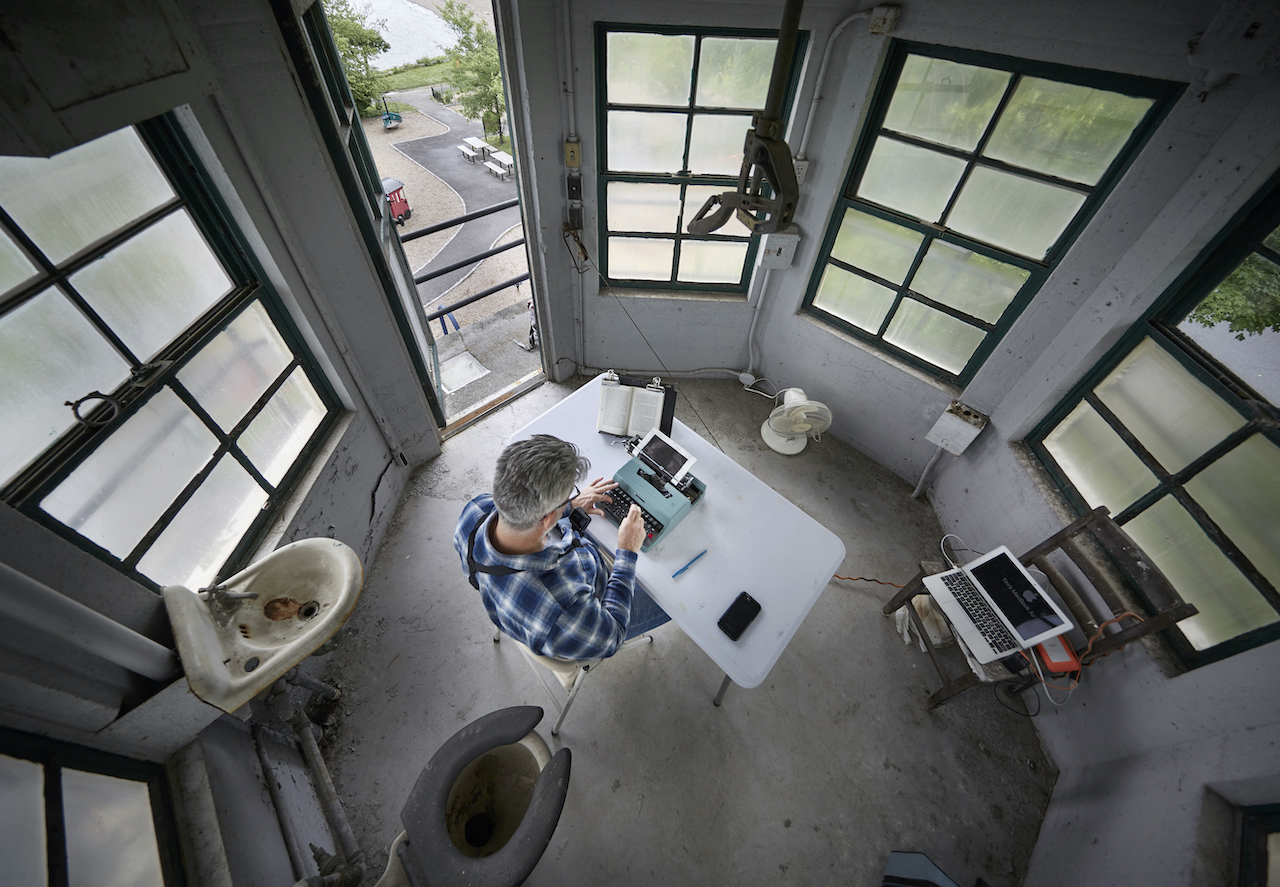
Performance and visual artist Tim Youd will visit the University of Nebraska–Lincoln to retype Willa Cather’s “O Pioneers!” from April 1-8.
Youd’s retyping of the Nebraska alumna’s novel will be the 72nd performance in his 100 Novels Project, in which he retypes whole literary works in iconic locations central to the author or story. The artist, who also works in painting, sculpture and video, will retype Cather’s “The Song of the Lark” at the National Willa Cather Center in Red Cloud from April 10-28 and “My Ántonia” in Omaha from May 1-10. Youd’s performances are in partnership with the university’s Willa Cather Archive, the National Willa Cather Center and Joslyn Art Museum.
When retyping, Youd types all of a novel’s words onto one page (which is backed by a second sheet) by running it repeatedly through the typewriter. The words become illegible, and the accumulated text becomes a rectangle of black ink inside the larger rectangle of the white page. Upon completion, Youd separates the two highly distressed pages and mounts them side-by-side in diptych form. The performance relic thus becomes a formal drawing, a representation of two pages of a book. The novel is present in its entirety, yet the words are completely obscured.
“One day I was sitting in my studio and holding a book,” Youd said, “and I had this moment of recognition where I saw that what I was looking at was this black rectangle of text inside the larger rectangle of the white page. I saw that as a geometric abstraction. And then I closed the book and tried to crush it in my two hands and get all the words to show up on one page, and to feel the texture and the weight of those words on one page.”
Youd has long been a devoted reader, and literature has connected his transition to becoming a full-time artist. He began a career in investment banking in New York City after graduating from College of the Holy Cross in 1989, then moved to Hollywood to produce movies and commercials. Around his early 30s, Youd said he found his career path unfulfilling and made the switch to art. Youd grew up around his mother’s artwork and had created art in his free time, and from there, he knew that this new trajectory would make him happy.
Youd has performed retypings across the United States and Europe, including William Faulkner’s “Rowan Oak” at the University of Mississippi Art Museum, Flannery O’Connor’s “Andalusia” at SCAD Museum of Art and Virginia Woolf’s “Monk’s House.”
While performing in Miami a few years ago, Youd met for breakfast with art curator Sarah Urist Green and author John Green. John pushed Youd to look into Cather’s writing since the artist was unfamiliar with her prose and impact on the Great Plains. After falling in love with “My Ántonia,” Youd began poring through the rest of her famed bibliography and gained an appreciation for her modernist approach and the “rolling beauty” in her language.
“I was hooked,” Youd said. “And I dug into it and thought about what this could really be in the retyping in the prairie and visiting her childhood town. The more I got into it, the more I felt like this is going to be one of the great experiences of the whole 100 novels.”
The Willa Cather Archive hosted Youd a few months ago to visit campus and discuss programming. Youd will sit at a desk outside of Architecture Hall and retype the novel on the same model of typewriter used by Cather. He chose this place to perform since it’s where an iconic photo was taken of Cather leaning against a large stone when she was a student in 1893.
“Tim’s performance is an interesting and new way to connect with Cather,” said Emily Rau, managing editor of the Willa Cather Archive. “I love his description of his project as producing artifacts in which stories are contained but cannot be read, in the form of a palimpsest. In many ways, the land we live on acts in this way, so it’s powerful to see such a visceral representation of the legacies of histories, stories and people, both people represented by Cather in her fiction and Cather herself.”
Youd will perform daily at the photo’s location from about 10 a.m. to 3:30 p.m. and will move to the vestibule on the north end of the Adele Hall Learning Commons in the event of inclement weather. He will also host a formal presentation with Aaron Holz, professor of art (painting and drawing), at 5:30 p.m. April 5 in Richards Hall, Room 15.
While performing, Youd said he’s focused in on his craft. He’s not just skimming through novels to retype the words; rather, he’s performing a closer reading of the text and translating it into a new art form. In the past, he’s put up a sign that explains what he’s doing but no longer displays one since it tends to shut off discussion. He also does not set expectations for how passersby will comprehend his work and leaves that interpretation up to the individual.
“I do get people who want to know what I’m doing and are curious about it and want to understand it in some depth,” Youd said. “And that’s satisfying to me when I can engage like that.”
While each person’s interest is up to their own ambition, Rau and the Willa Cather Archive hope that students and faculty walk away with ideas for different ways to interact with texts.
“Tim’s performance provides a moment for a different type of engagement with Cather, her work, the campus and conceptions of place,” Rau said.








